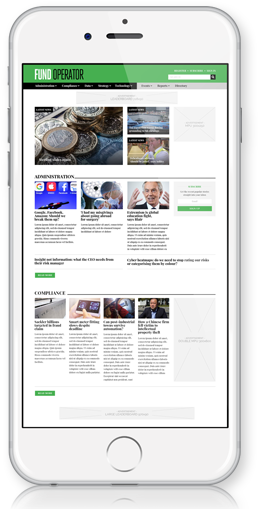 Maria Long, Partner, ORC.
Maria Long, Partner, ORC.
Andrew Putwain: Can you introduce yourself, your role, and what it is you do?
Maria Long: I’ve spent just under 25 years in the hedge fund and alternative spaces, working across a range of roles.
I led the middle office at the FRM (later acquired by Man Group). Before joining OCR as a partner, I was a Director at the Standards Board for Alternative Investments (SBAI), where I led industry working groups and authored thought leadership papers on topics such as Insurance-Linked Securities and responsible investment. At ORC, we work in consultancy, supporting both asset allocators and asset managers. Our services range from Operational Due Diligence (ODD) and Investment Due Diligence (IDD), initial and ongoing, to ESG due diligence.
Andrew: In a fast-paced environment, what specific mechanisms or governance practices have you seen successfully drive holistic decision-making, without slowing things down?
Maria: I’ve worked with many asset managers and allocators ranging from first-time fund launches to multi-billion-dollar institutions, with the entire spectrum showing governance challenges as a recurring issue. Problems typically emerge at either end of the governance spectrum, whether it is models that are too centralised, where all decisions are funnelled to the top, or those that are too fragmented, with decision-making spread thin across too many groups. The most effective governance sits somewhere in the middle; structured, but agile.
"The most effective governance sits somewhere in
the middle; structured, but agile."
High-level accountability at the board or executive committee level is essential, but as an organisation grows, these bodies shouldn’t be the only decision-makers. Instead, their role should be set to strategy and retain oversight for key matters, clearly defined and documented in a ‘terms of reference’, such as material cost approvals or strategic shifts. The key to efficient, risk-aware decision-making is clear delegation of authority. In smaller companies, this might mean giving the Chief Investment Officer or Chief Operating Officer discretion over certain areas. In larger companies, it usually means establishing separate committees with well-defined mandates.
One of the most common gaps we uncover in governance reviews is the lack of formalised committee structures. Every governance forum, whether it’s investment, risk, or operations, should have clear terms of reference or charter that spells out its responsibilities. Without this structure, decisions often default to the top, creating bottlenecks and slowing down the organisation. In short, good governance enables action, rather than blocking it.
Andrew: What are the most common blind spots or friction points you’ve observed when companies try to embed risk thinking into strategic decision-making, and what practical steps can help overcome them?
Maria: One of the most consistent themes we see in our reviews, regardless of a company's size or maturity, is a lack of holistic risk thinking. In particular, transition risk is often overlooked or poorly managed.
Strategic decision-making should factor in a broad range of risks, including operational, regulatory, counterparty, liquidity, market, and more. While most companies have individuals or teams overseeing these areas in isolation, often missing from these is a consolidated, company-wide view. Without that, it becomes difficult to assess how strategic choices impact the overall risk profile or to weigh decisions through a risk-rewarded lens.
The solution starts with governance. Companies should establish a risk committee that includes representation from all key functions. In smaller companies, one individual might wear several hats; in larger companies, it could be department heads. Each strategic decision should undergo a formal risk assessment, benchmarked against the company's defined risk appetite, and reviewed by this committee before moving forward. The results should then be escalated to the governance forum that holds final decision-making authority.
Transition risk, the temporary yet often significant risk that arises during the execution of a strategic change, is a major blind spot. It tends to fall between the cracks, not clearly owned by any one team. To manage it effectively, companies may want to form a steering committee for major initiatives, or at a minimum, ensure implementation oversight becomes a standing item in the relevant governance forum.
"Transition risk, the temporary yet often significant risk that arises
during the execution of a strategic change, is a major blind spot."
Finally, culture plays a critical role. Even with the right structures in place, if people don’t feel empowered to challenge decisions or raise concerns, then risk governance becomes a box-ticking exercise. Real risk management requires not just process, but participation and voice.
Andrew: What practices allow companies to maintain compliance and governance standards while staying nimble enough to respond to regulatory shifts or emerging disruptions?
Maria: To navigate disruption and regulatory changes effectively, companies need both solid foundations and the flexibility to adapt. Those that are too rigid in their structures or thinking will struggle, especially as the pace of change accelerates.
One common pitfall is hard-coding controls too narrowly around current regulations. While that may tick compliance boxes in the short term, it limits flexibility further down the line. A more practical approach is to design controls around broader risk themes, making them configurable and adaptable as rules evolve.
This ties back to governance. When the right forums are in place, and compliance, legal, operations and other business functions are already working together routinely, the organisation is far better positioned to respond quickly, and more importantly, coherently, to regulatory changes, making coordination critical. A regulatory change may be the catalyst, but it often triggers knock-on effects across the entire operating model. Understanding and addressing those implications up front enables smoother, more efficient implementation.
Culture also plays a central role. Companies that embed accountability, transparency and collaboration into their culture will respond more effectively to change. But when internal functions compete for visibility or budget, it creates a defensive environment and in that kind of culture, transition risk increases because coordination breaks down.
Andrew: How does working across different teams help companies make better decisions, and what are some effective ways to break down silos between departments, especially in large organisations?
Maria: One of the biggest challenges we see in ODD reviews or large organisations is siloed thinking. It’s often difficult to map end-to-end processes because no one has full visibility. In operations, especially, teams can function like an assembly line, each person focused on a narrow task without understanding the bigger picture. This creates risks on multiple fronts.
When people don’t see how their work connects to broader outcomes, inefficiencies creep in. Tasks continue long after they’ve lost relevance, and critically, engagement suffers. Employees are more likely to disengage, and eventually leave if they don’t see the value or impact of their contributions.
Cross-functional collaboration consistently leads to better decision-making. It brings diverse perspectives to the table, reduces blind spots and surfaces risks and opportunities faster. However, the larger the organisation, the harder this collaboration becomes.
Senior-level governance forums help, but meaningful collaboration needs to happen at all levels. Companies can implement shared KPIs across departments to align teams around common goals, rather than competing priorities. They can also establish cross-functional working groups, blending seniority levels and business units, so people regularly sit together, build trust, and deepen mutual understanding.
"When leaders prioritise connection over division, the entire organisation
becomes more resilient, responsive, and engaged."
Short-term secondments or rotation programmes are another tool. These not only help retain institutional knowledge and strengthen inter-team relationships but also support career development, boosting retention in the process.
This comes down to leadership. Senior executives need to model and reward collaborative behaviour. If the tone from the top reinforces silos, through language, incentives, or culture, then efforts to break them down will fail. But when leaders prioritise connection over division, the entire organisation becomes more resilient, responsive, and engaged.
Andrew: Finally, what are the important areas people should focus on when looking at this topic?
Maria: Governance, risk management, and collaboration are essential to any company's success, but what they look like varies widely depending on the organisation’s size, stage of maturity, and jurisdiction. These frameworks also can’t remain static. As a company evolves, so must its controls, processes, and decision-making structures.
We often work with companies at an inflexion point. They’ve grown, adding headcount, layering new technology onto legacy systems, and the operating model begins to show strain. Responsibilities become misaligned over time, and task mapping often reflects history more than current business logic. What worked a few years ago may now be inefficient or risky.
At this stage, it’s critical to step back and reassess. There are usually opportunities to streamline operations, modernise technology and realign teams to help focus on higher-value or newly emerging activities. Governance, risk, and compliance frameworks also need to evolve, not just to reflect what the company is, but to remain agile enough for where it’s going.
This kind of transformation is difficult to drive from within. Internal teams may lack the bandwidth, objectivity, or external reference points, especially in companies where long tenure means limited exposure to how other organisations operate.
That will help companies redesign their frameworks to be both fit for purpose and future ready.
Maria will be speaking at Insurance Investor Live | Europe 2025 on September 24 and 25 in London. Find out more and how to register here.
Please Sign In or Register to leave a Comment.
SUBSCRIBE
Get the recent popular stories straight into your inbox







